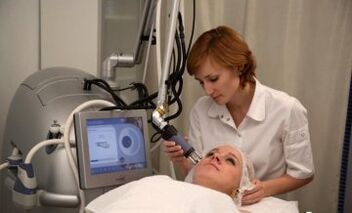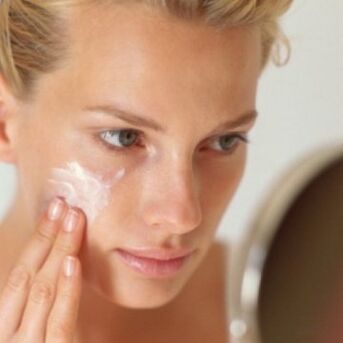
Fractional thermolysis (fraxel) is a method of laser "rejuvenation" of the face and body that helps cope with age-related and stressful skin problems.
This procedure is almost as effective as a surgical orthodontist, and after thermolysis, skin cells begin to actively produce collagen and elastin, which means that beneficial changes occur not only in the outer epidermis but also in multiple layers at once.
The procedure is very effective, but at the same time traumatic. It can only be performed in special clinics.
What it is - fractional photothermolysis, what is the essence and effectiveness of the method, indications and contraindications for facial and body procedures with fraxel technology, before and after photos, consequences and opinions about the laser procedure, estimated prices and what tools are used - we will try to tell you more.
general information
Thermolysis is the process of structural destruction of tissue under the influence of high temperature. The concept was created and mediated by doctors and then introduced by beauticians.
And photothermolysis is also a process of thermolysis, but it is caused by light energy. It is used in cosmetology during photoepilation and laser "repainting" of scars and scars.
Fractional photothermolysis is a technique in which photothermolysis does not affect the entire surface of the skin, but only certain areas of it. This means that we can talk about the focal destruction of tissues by heating with the help of laser (light) energy.
The substance of the procedure and other names
The fractional photothermolysis method is one way of negatively stimulating the skin, as certain types of injuries, in this case burns, are used during the treatment.
To achieve the expected cosmetic result, a regeneration process must be initiated that restores the skin after damage.
This type of thermal burn appears to be a "column" formed in the thickness of the dermis by the targeted action of laser beams. This "column" is referred to in cosmetology as the "microscopic treatment zone" or MLZ for short.
Their diameter should not exceed one tenth of a millimeter: about 0, 1-0, 4 mm, their penetration depth not exceeding 0, 5 mm. Depending on the type of procedure chosen, tens of thousands of such microtraumas can be placed on one square centimeter of surface while the impact velocity is 3000 MLZ / sec.
If the mechanism of action of fractional photothermolysis is analyzed, it is similar to mesoscooter therapy, but when using a cylinder, microinjuries are applied mechanically with needles.
In cosmetology practice, the term fractional thermolysis has several commonly used synonyms:
- dermal optical thermolysis;
- DOT therapy;
- fractional laser "polishing";
- LAFT rejuvenation;
- fractionated laser nanoperforation;
Ablative and non - ablative method
Laser ablation is the evaporation of a substance using a laser pulse. When using ablative fractional photothermolysis, choose laser radiation whose energy is largely absorbed by water molecules.
The laser beam heats the water in the tissues to 300 C almost immediately upon short-term exposure to a specific area. As a result, the entire "column" evaporates and an open-type microscopic wound is formed in its place, surrounded by thermally coagulated cell layers.
After ablative photothermolysis, recovery will be much slower and longer than with the non-ablative method.
But the result of the procedure will be objectively better and the lifting effect will be clearer. It is best to use a course of 2-6 sessions. But in such procedures, the patient is at some risk of infecting the deep dermal layers of the tissue.
Non-ablative fractional thermolysis can be attributed to more gentle microtrauma techniques. They use a laser beam that does virtually no damage to the epidermis, causing burns underneath.
The dead tissue does not evaporate but remains "inside the column", of course there is no open wound. Lifting is not as obvious as in the first ablative method because the cellular breakdown products were not removed during the procedure, which means that the skin"tightening" has no effect.
It is recommended to use courses of 3-10 occasions. There is virtually no risk for the patient to infect the deep dermal layer as it does not compromise the integrity of the surface.
Indications, effect
Indications for the designation of a procedure using Fraxel technology may include the following:
- the need to stimulate withered and aged skin;
- treatment of pigmented / depigmented lesions;
- getting rid of scars, post-acne and small scars;
- the need to remove stretch marks.
Not suitable for removing keloid formations.
Advantages
How is this method different from the classical laser "polishing"? With the traditional approach, the combustion covers a large area, and with fragmentary exposure it is localized and point-like.
Burns include intact skin surfaces, making photothermolysis less traumatic and accelerating healing time.
The method is suitable for treating any part of the body, but in most cases it is applied specifically to the face. When using Fraxel technology, the beautician can even work on the skin of the eyelid.
One feature of this optical thermolysis of the dermis is the innovative design of the DOT device itself, which avoids the absence of skin areas or overlapping of one of the zones.
Mechanism of action
At the preliminary consultation, the beautician determines the goals the client wants to achieve, finds out the possible contraindications to the procedure, talks about the possible outcomes and how these meet the client’s expectations.

Your doctor will certainly determine a point about the risks and development of postoperative complications and how to care for your skin after photothermolysis.
The appropriate method of analgesia should be discussed in advance and the client should be notified of any allergic reactions to the medication, if any.
A few hours before the session, a superficial peeling is performed to even out the thickness of the stratum corneum of the skin.
During surgery, the patient may experience moderate pain and discomfort. Their severity must not depend in any way on the type of device used. The degree of pain is determined by the depth and intensity of the laser beam, and these parameters are determined by one skilled in the art, with a focus on therapeutic purposes.
The more neglected the problem, the deeper the layers to be touched.
But ordinary anesthetic creams are usually used as anesthetics, applied to work areas up to 40 minutes before the start of the session.
During the session, the beautician moves a nozzle on the surface that emits a targeted laser beam. If such a need arises, the same area will be re-treated under the same procedure.
The duration ranges from 15 minutes to 1 hour. It all depends on how much skin is treated. After the fractional photothermolysis is completed, a soothing cream is applied to the "polished" surface.
Several procedures must be performed to achieve the desired result - 3 to 10, depending on the type of exposure chosen. You can have a session once a month.
Recommendations (training and rehabilitation)
A few days before the scheduled procedure, the patient should begin prophylactic treatment with antibiotics and antiviral drugs. Of course, if there is objective evidence of this.
On the day the fractional photothermolysis takes place, the person should avoid alcohol and completely abstain from sports.

After the non-ablative photothermolysis procedure, the recovery process takes up to three days, after the ablation type - at least one week.
If the "polishing" was based on ablation, the patient's skin will turn red for a few more days, causing swelling, a burning sensation, and discomfort.
After consulting a doctor, you can apply a cooling compress or local painkiller on the skin, available as a spray.
After at least three days, the color of the "polished" dermis may change slightly. For example, it may turn pseudo-brown due to increased degradation of pigmented residues from previously dead cells.
Dryness occurs, peeling begins, and a person may even experience itching for a short time. All of these manifestations are not dangerous and will go away on their own in about a week. Scratching itchy skin is strictly forbidden!
In order for post-fraxel rehabilitation to go without complications, you need to follow some basic recommendations:
- you should take care of your skin and be sure to use the recommended external products. In most cases, these are medications that are prescribed to treat thermal burns and moisturizing sprays;
- the bark formed on the surface during wound healing must not be artificially removed, only a natural fall;
- if the patient has taken antimicrobials and antivirals prior to the procedure, treatment should be continued as directed;
- in order to prevent the development of hyperpigmentation, the treated skin should be isolated from direct sunlight for at least one month. Usually use SPF 40+ sunscreen;
- the use of exfoliators and other mechanical skin cleansing methods is prohibited throughout the recovery period.
Possible side effects and complications
Although fractional photothermolysis is one of the most modern and safest methods, it has several side effects:
- development of bacterial infection, streptoderma or staphyloderma;
- redness lasting more than three days;
- edema on the surface of the treated skin lasting more than two days;
- hyperpigmentation in the post-inflammatory period;
- appearance of burn blisters, erosive cracks;
- exacerbation of HSV1 or acne;
- microscopic bleeding under the skin.
Contraindications (general and local)

Fractional photothermolysis is not performed with the following general contraindications:
- oncological tumors;
- the period of breastfeeding;
- HSV1 and HSV2 in the acute stage;
- infectious diseases;
- chronic diseases in the manifestation stage;
- any type of diabetes mellitus;
- defects and inadequacies of the cardiovascular system;
- disorders of the organs of the hematopoietic system, poor blood clotting;
- presence of autoimmune diseases;
- prone to the formation of keloid-type deep scars;
- epileptic condition or convulsive syndrome;
- psychic abnormalities;
- taking isotretinoin for six months;
- last tan or visit to the solarium.
And the following local contraindications:
- all inflammatory processes localized in the planned work area;
- damage to skin integrity;
- tumors of unknown origin;
- dry cleansing of the skin or any other procedure that may damage the skin.
Where and on what means they are performed, approximate prices

The cost of a fraxel procedure depends on the area being treated, so the estimated cost of fractionated laser surface treatment varies.
Only trained professionals may perform photothermolysis in a cosmetology hospital.
Devices with CO2 or erbium laser are used for the fraxel rejuvenation process itself. Ordinary beauty salons usually do not have the necessary equipment or trained staff.
The use of lasers for cosmetic purposes is still controversial. But in any case, laser-based procedures are the most popular, most effective, and safest.
Opinions
We invite you to read some opinions about fractional laser facial rejuvenation:
- First rating: "I’m 35 years old. I went for fractional photothermolysis 2 times. The second visit took place 30 days after the first visit. As a result, I noticed that my pores, which were usually slightly enlarged, were constricting, and the skin on my forehead and face became much smoother. I was satisfied. It was only the peeling that occurred after the second visit caused me discomfort. But three days later he disappeared without a trace. Now I look in the mirror and enjoy my own face. "
- Second evaluation: "I would like to tell you what my impressions of this method are because I felt a positive result. After three procedures, I noticed that my face was lightening, the pigment spots on some parts of the face were lightening, the scars were starting to stand out less noticeably, the skin was tightening. These changes did not happen all at once, but gradually. After about 4 months, I started to look 5-6 years younger than I was. I would advise anyone who takes care of themselves to try this amazing thing.
- Third Review: "I was very afraid of such procedures because I thought they had more undesirable consequences than plus. However, when the first wrinkles appeared, the thought of "magical skin remodeling" came to my mind more and more often. That's why I decided to do a photothermolysis. In the process, there were mildly painful but tolerable feelings. wrinkles around the eyes smoothed out, the complexion became lighter, the contour tightened. I usually liked the effect. I will reapply this procedure if necessary.
- Fourth Review: "I find this method indispensable for any woman who wants to stay young and attractive. I discovered something new for myself and was extremely pleased. There are many positive moments, and all of them were reflected on my face: the fine wrinkles and pigment spots are gone, the skin is not so flabby, there is less inflammation, and most importantly, I love myself much more. I would like to advise everyone to love themselves, not to skimp on their beauty, and to apply effective procedures to preserve their youth.















































































